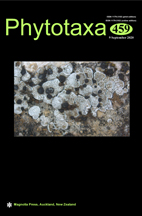Abstract
A phylogeny of all nine subgenera of Drosanthemum, based on chloroplast sequence-data, is presented. The results confirm some previously published facts, e.g. that D. zygophylloides is sister to Drosanthemum. We propose to treat this species as a new monotypic genus, Lemonanthemum, which differs from Drosanthemum in features of the leaves and fruit-stalks. In Drosanthemum s.s., the small subg. Quadrata, characterized by 4-locular fruits, is highly supported as sister to the remainder of Drosanthemum (where fruits are 5-locular). Further, our data support the transfer of Delosperma pubipetalum to Drosanthemum (where a nomenclatural change is also made). The pubescent petals, 5-locular fruits with narrow covering membranes and downward-pointing hair-like papillae on the branches suggest that D. pubipetalum is close to D. papillatum and belongs to subg. Quastea. Another species, D. badspoortense, which had been placed in D. subg. Quastea on account of its narrow covering membranes, is shown to belong to Delosperma and also lacks the unique structure of the fruit-stalk of Drosanthemum. In addition, a new species, D. overbergense, is described from disjunct patches of remnant renosterveld within the Overberg and near Albertinia, in the Western Cape of South Africa. Morphological characteristics suggest that this species belongs to subg. Xamera, but this was not corroborated by our molecular data. Finally, a new name—Drosanthemum calcareum—is proposed for the illegitimate D. intermedium and a lectotype (at BOL) is designated for D. pubipetalum. The lectotypification of D. badspoortense is also proposed.

